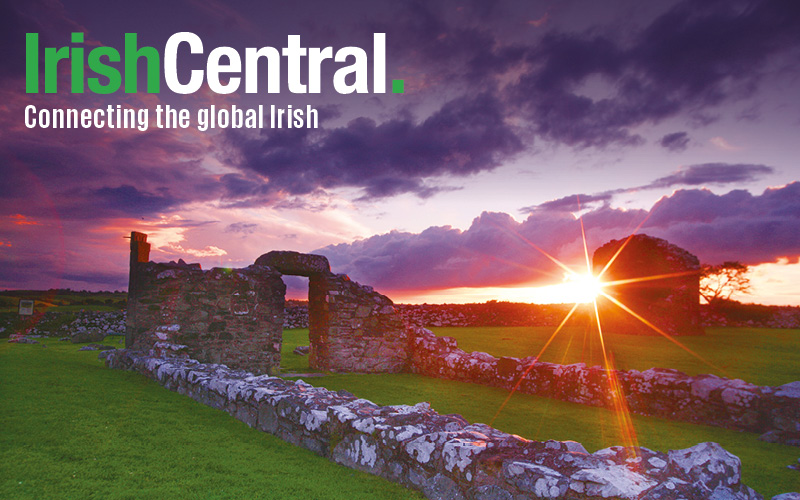The largest medieval stone cross in Ireland lies in the townland of Ray just outside the town of Falcarragh in Co Donegal.
The Saint Colmcille’s cross stands 5.56m (18.2ft) high and 2.26m (7ft 5in) across. It is made of Muckish slate.
Standing in the ruins of the Church of Ray, the cross has an ancient history and has witnessed saints and slaughter.
Read More: The Donegal Taj Mahal - The Old Church of Dunlewey
Historians believe that the first church of Ray was founded by St Fionán in the sixth century.
Folklore tells a tale that the cross was sculpted from a solid rock quarried on Muckish Mountain and was originally commissioned by St. Colmcille (521-597) and to be erected on Tory Island.
However, St. Colmcille instead gave it as a gift to the Fionán, who had miraculously retrieved Colmcille's lost gospel.
Alas, this tale is but a legend, as the cross has been dated to the 8th century, well after the time of Colmcille and Fionán.
Despite this, there is a clear link with Iona, the final resting place of Colmcille, as the cross is virtually identical to the Saints John’s Cross on Iona which dates from the same period.
The cross in Ray stood until it was knocked down in a storm in 1750.
Tragically it lay neglected and broken in 2 pieces for 220 years, until the Donegal office of public works decided to restore the cross in 1970.
The cross is now held together by 2 metal strips and back in one piece, it stands majestic in the ruined church of Ray.
Read More: Canon James McFadden – Donegal priest fighting against injustice
The church itself stands on the east bank of the River Ray and near its estuary.
From the 6th to the 8th centuries, the river was a boundary between two small kingdoms, the Cineál Duach on the east of the river and the Cineál Lughdach on the west.
A Roman Catholic church survived in various guises until the coming of Cromwell.
The Catholic church of Ray was destroyed by a platoon of Cromwellian soldiers under the command of Captain Robert Cunnyngham.
Cunnyngham was the constable of Doe Castle, which had been captured in 1650 by Cromwellian forces from Derry.
Later in 1650, the Cromwellian forces routed the Catholic Ulster army at the battle of Scarrifholis.
On the 21st of June 1650, the Irish Confederate army commanded by Herbert MacMahon the Roman Catholic Bishop of Clogher, faced the Cromwellian New Model Army and local ulster protestant settlers led by Charles Coote, 1st Earl of Mountrath.
The Catholic army was annihilated and lost most of its weapons and supplies. This catastrophic defeat secured the North of Ireland for the New Model Army and was a major factor in the Cromwellian conquest of Ireland.
It was in this turbulent time, that Robert Cunnyngham led a platoon of soldiers to commit an atrocity against the catholic worshipers of Ray church, whom they believed to be heretics.
The Cromwellian soldiers approached the church and while the congregation was gathered inside hearing mass they burst open the doors.
The entire congregation was slaughtered in what was to become known as the ‘Massacre of Ray’ (Marfach Raithe).
The bodies of the dead were buried in a mass grave within two hundred meters of the church at a place called ‘Resting place of the Bones’ (Lag Na gCnamh).
The church continued to be used by the Church of Ireland until the early 19th century until it fell into its present state of decay and disrepair.
A number of gravestones scatter the grounds, many from the Olphert family, local landlords of the time. The Olphert 18,133 acre estate surrounded Falcarragh and Ardsmore, north of Gweedore. The Olpherts were descended from a Dutch Protestant who had bought the property in 1661.
The Church of Ray now stands as a ruin, just off the N56 on the Falcarragh to Ballyboe road and is well worth a visit. I’d urge you all to seek it out when in the local area.
As for Robert Cunnyngham, he continued his murderous campaign of religious genocide and was involved in the massacre of 63 catholic men women and children on the Island of Arranmore.
He met his end at the hands of 2 vengeful survivors from the Arranmore massacre at Doe Castle, where he was the Cromwellian Constable.
Justice, at last, some might say.
Read More: How a Donegal "fighting" priest took on his parishioner's landlords
This article was submitted to the IrishCentral contributors network by a member of the global Irish community. To become an IrishCentral contributor click here.




Comments